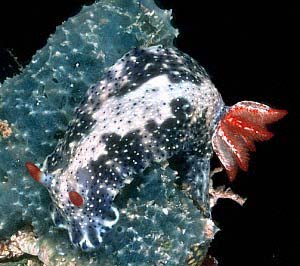
Hypselodoris saintvincentius
(Burn, 1962)
Order: NUDIBRANCHIA
Suborder: DORIDINA
Family: Chromodorididae
DISTRIBUTION
Known only from South Australia, and southwestern Western Australia.
PHOTO
southern Yorke Peninsula, South Australia, February 1985. On Dysidea? sp. PHOTO: Bill Rudman.
This is part of a complex of related species including Hypselodoris obscura found in southeastern Australia, and Hypselodoris infucata which has a wide Indo-West Pacific distribution.
-
Burn, R.F. (1962) Notes on a collection of Nudibranchia (Gastropoda: Dorididae and Dendrodorididae) from South Australia with remarks on the species of Basedow and Hedley, 1905. Memoirs of the National Museum, Melbourne, (25): 149-171, pl. 1.
-
Johnson, R. F. and Valdés, A. (2001) The Hypselodoris infucata, H. obscura and H. saintvincentius species complex (Mollusca, Nudibranchia, Chromodorididae), with remarks on the genus Brachyclanis Ehrenberg, 1831. Journal of Natural History 35: 1371-1398.
Rudman, W.B., 1998 (November 28) Hypselodoris saintvincentius (Burn, 1962). [In] Sea Slug Forum. Australian Museum, Sydney. Available from http://www.seaslugforum.net/find/hypssain
Related messages
Hypselodoris saintvincentius from Western Australia
March 8, 2007
From: Bruce Potter
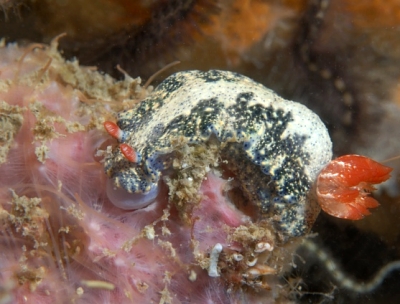
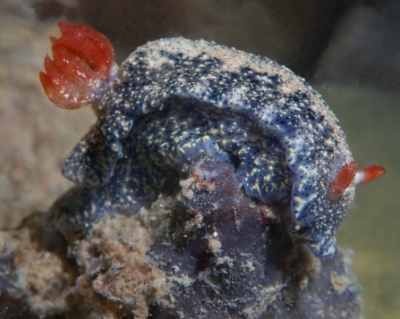
Dear Bill,
This is another one from Rockingham jetty. I found this Hypselodoris infucata clearly eating and so thought you might be interested. the other one was nearby. There were many H. infucata under this jetty.
It would have been about 35 to 40mm long and was at about 5 metres deep.
Locality: Rockingham, 5metres, Western Australia, Indian Ocean, 24 February 2007, Mucky under Jetty. Length: 35-40 mm. Photographer: Bruce Potter.
Regards
Bruce Potter
bandppotter@bigpond.com
Potter, B., 2007 (Mar 8) Hypselodoris saintvincentius from Western Australia. [Message in] Sea Slug Forum. Australian Museum, Sydney. Available from http://www.seaslugforum.net/find/19603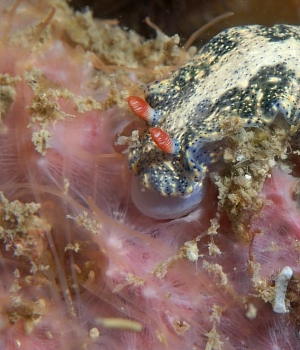
Thanks Bruce,
It is always good to get feeding records like this. The animal is Hypselodoris saintvincentius, which is very similar in colour to H. infucata. One consistent difference seems to be that the gills appear 'fuller' than in H. infucata and have opaque white marks, or a line, up the basal half of the outer edge of each gill and in the upper half the red seems to line not only the outer edge but the edge of each gill lamellae as well.
We have a previous record from Rockingham on the Forum [#14263]. The pink sponge in the upper photo looks very like the species of Dysidea being eaten by H. infucata in an earlier message [#17805]. Its possible that the dark blue sponge in the other photo is the species of Dysidea illustrated in the Fact Sheet for H. saintvincentius, though we can't say for sure the slug is feeding on it.
Best wishes,
Bill Rudman
Hypselodoris saintvincentius from Port Noarlunga, SA
January 10, 2007
From: Steve Reynolds
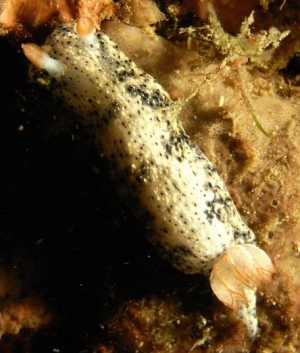
Hi Bill
Is this photo Hypselodoris saintvincentius?
It's from Port Noarlunga, South Australia. It was seen on a night dive on 28 December 2006 by Paul Macdonald.
Regards
Steve Reynolds
stever@sdfsa.net
Reynolds, S.J., 2007 (Jan 10) Hypselodoris saintvincentius from Port Noarlunga, SA. [Message in] Sea Slug Forum. Australian Museum, Sydney. Available from http://www.seaslugforum.net/find/19105Dear Steve,
Yes this is Hypselodoris saintvincentius.
Best wishes,
Bill Rudman
Hypselodoris saintvincentius from South Australia
August 26, 2005
From: Dennis G. Hutson
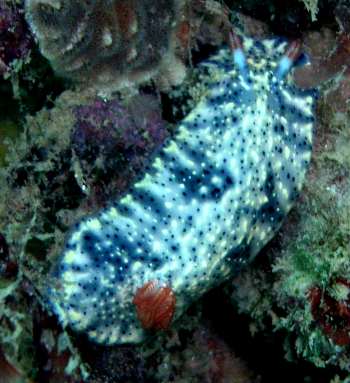
Could you please confirm the id of this critter. The photo was taken at a site known as the Glenelg Blocks, which is located approx. 500m off the beach of Glenelg, South Australia, Gulf St. Vincent. I was told it was Hypselodoris infucata but I thought it might be Hypselodoris saintvincentius. I understand there is a slight difference in colour. Thanks for your help.
Locality: Glenelg Blocks off Glenelg Beach, South Australia, Southern Ocean. Depth: 5 m. Length: 40 mm. 21 November 2004. Rocky bottom
Photographer: Dennis Hutson
Cheers
D.
dghutson@ozemail.com.au
Hutson D.G., 2005 (Aug 26) Hypselodoris saintvincentius from South Australia. [Message in] Sea Slug Forum. Australian Museum, Sydney. Available from http://www.seaslugforum.net/find/14629Dear Dennis,
The sad death of a young marine biologist yesterday by a Great White Shark, while diving just off Glenelg, must make you wonder if the region is really the best place to go looking for nudibranchs ....... Your animal is Hypselodoris saintvincentius. As I discuss in a recent message [#14285], it is not that easy to separate from H. infucata.
Best wishes,
Bill Rudman
Hypselodoris saintvincentius from Western Australia
July 19, 2005
From: Mick Tait
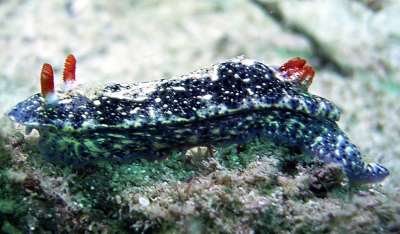
Dear Bill,
Thanks for your feedback [#14263]. I am very new to U/W Photography and identifying Nudibranchs. I've got my 'L' plates on.
This particular photo was originally identified as Hypselodoris infucata using the book Sea Slugs of Western Australia by Fred E. Wells & Clayton W. Bryce. I refer to page 114-115 #140. If others have a copy of this book, I'd like to receive comments about this identification. I may be that there is some confusion for this identification in the book. Should it actually be identified as Hypselodoris saintvincentius?
Locality: Bell Beach Rockingham, Cockburn Sound, Western Australia. Depth: 12 m. Length: 35 mm. 18 June 2005. Sandy/Silt Bottom. Photographer: Mick Tait
Mick Tait
mick@bluesphere.com.au
Tait, M, 2005 (Jul 19) Hypselodoris saintvincentius from Western Australia. [Message in] Sea Slug Forum. Australian Museum, Sydney. Available from http://www.seaslugforum.net/find/14285Dear Mick,
I'm afraid nothing the first lesson you will learn is that there is an awful lot we don't know. I suspect I may have suggested Fred & Clay identify their photo as H. infucata when they weere preparing their book, as I had serious doubts about whether H. saintvincentius was good species or just a peculiar geographic colour variant of Hypselodoris infucata. Your side view here shows the diamond shaped pattern which I recently mentioned [message #14188]. However a recent study has decided that it is a good species so at least for the present, that's what I am calling it. Although changing names can be irritating, it is also a sign that someone is researching the animals, so that's a good thing.
- Johnson, R. F. and Valdés, A. (2001) The Hypselodoris infucata, H. obscura and H. saintvincentius species complex (Mollusca, Nudibranchia, Chromodorididae), with remarks on the genus Brachyclanis Ehrenberg, 1831. Journal of Natural History 35: 1371-1398.
Best wishes,
Bill Rudman
Hypselodoris saintvincentius mating.
July 18, 2005
From: Mick Tait
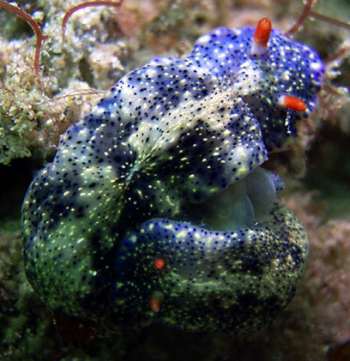
Photographed on the Bell Beach Wreck Trail - Rockingham. I occasionally happen across Hypselodoris infucata on the Wreck Trail dive site, not very common. First pair I've seen together and they were mating.
Locality: Bell Beach, Rockingham, Cockburn Sound, Western Australia. Depth: 8 m. Length: 50 mm. 09 July 2005. Along guide ropes. Water Temp now 14-deg C in Cockburn Sound Photographer: Mick Tait
Mick Tait
mick@bluesphere.com.au
Tait, M, 2005 (Jul 18) Hypselodoris saintvincentius mating.. [Message in] Sea Slug Forum. Australian Museum, Sydney. Available from http://www.seaslugforum.net/find/14263Dear Mick,
This is not Hypselodoris infucata but a related species, Hypselodoris santvincentius, known only from South Australia and southwestern Western Australia. Its nice to get another record of it from Western Australia
Best wishes,
Bill Rudman
Hypselodoris saintvincentius from Sth Australia
March 9, 2005
From: Carl Mooney
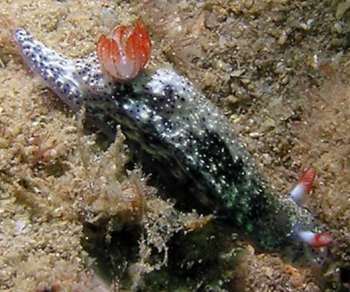
Hi Bill,
I'm pretty sure this is another variety of Ceratosoma amoena found in the temperate waters of South Australia. If you can please let me know approximately how many variations in colour there are it would be much appreciated.
Locality: Pt Stanvac, South Australia, Gulf St Vincent. Depth: 12 metres. Length: 25-30 mm 26 February 2005. debris, rocks, sand. Photographer: Carl Mooney
This site is invaluable for nudibranch enthusiasts, but I was wondering if you could recommend a good book on the subject for species in and around Southern Australia.
Regards,
Carl
selenite@bigpond.net.au
Mooney, C.H., 2005 (Mar 9) Hypselodoris saintvincentius from Sth Australia. [Message in] Sea Slug Forum. Australian Museum, Sydney. Available from http://www.seaslugforum.net/find/13300Dear Carl,
It certainly in general shape looks like Ceratosoma amoena and they are both in the family Chromodorididae, but this is Hypselodoris saintvincentius, a species restricted to south and south-western Australia.
Concerning books on South Australian sea slugs. Have a look at the Book Review Section. The book by Fred Wells & Clay Bryce - Sea Slugs of Western Australia, and Neville Coleman's 1001 Nudibranchs - Catalogue of Indo-Pacific Sea Slugs cover some of the fauna you will encounter, but we still have quite a bit to learn about the fauna of that part of Australia. You have a mixture of local endemic species found nowhere else, another group found across all of temperate Australia, and a third group of tropical species which sometimes appear to hitch a ride as larvae, in warm water currents down the west Australian coast.
Best wishes,
Bill Rudman
Hypselodoris saintvincentius from South Australia
November 28, 2001
From: Stuart Hutchison
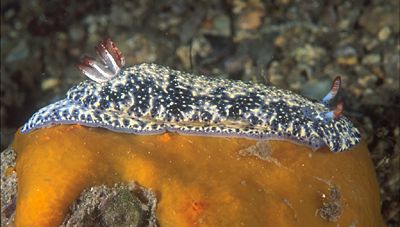
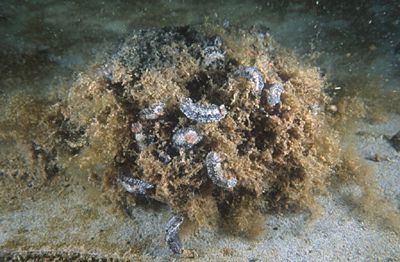
Hi Bill,
The upper photo is H. infucata from Port Hughes, South Australia in May 2000 (about 70mm long in 7m of water). It was a very nice specimen. The other photo was from Wallaroo, about 20km away. There, the grain conveyors spill grain dust into the water on a regular basis, which forms a soft silt on the bottom. For some reason there are usually thousands of H. infucata clinging to the smaller algae covered rocks under the jetty where the silt accumulates.
Regards,
Stuart
stuart@stuarthutchison.com.au
Hutchison, S., 2001 (Nov 28) Hypselodoris saintvincentius from South Australia. [Message in] Sea Slug Forum. Australian Museum, Sydney. Available from http://www.seaslugforum.net/find/5686Dear Stuart,
Thanks for these interesting photos. This animal is in fact Hypselodoris saintvincentius, which looks very like Hypselodoris infucata, but is apparently a southern relative of that widespread Indo-West Pacific species. Hypselodoris obscurafrom southeastern Australia, is another very similarly coloured species.
I suspect why you find it clustered in groups on rocks, is that the rocks are the only place that their sponge food can attach and grow. I may be imagining it but the rock on which your animals are clusterd seems to have a greyish-blue sponge growing on it like the one in my photo at the top of the page. I am not sure just how soft the grain dust sediment is but if the slugs can't crawl on it then they may be essentially prisoners on each rock. They possibly arrived as planktonic larvae and are stuck there until the food runs out. perhaps next time you are there you could check out the rocks to see if there is a layer of sponge on them, and perhaps put a couple of slugs temporarily on the grain dust sediment and see if they can crawl on it. If you ever come across them laying eggs, I would love to see a photo of their egg mass.
Best wishes,
Bill Rudman
